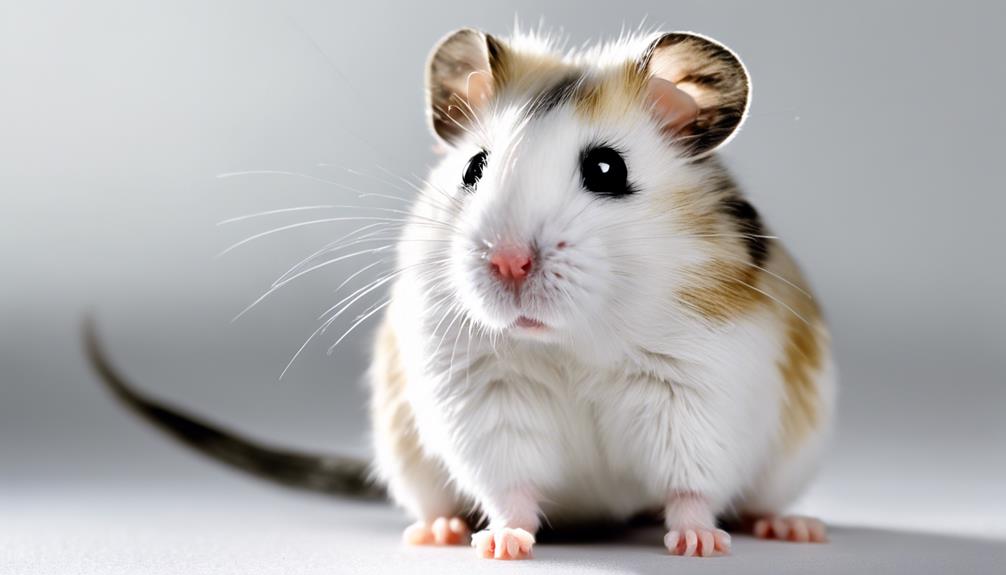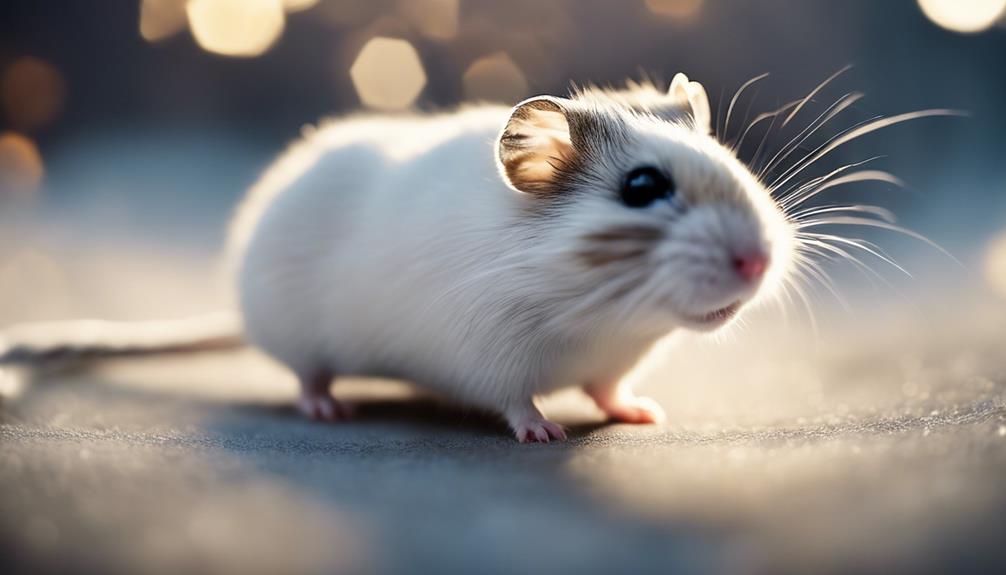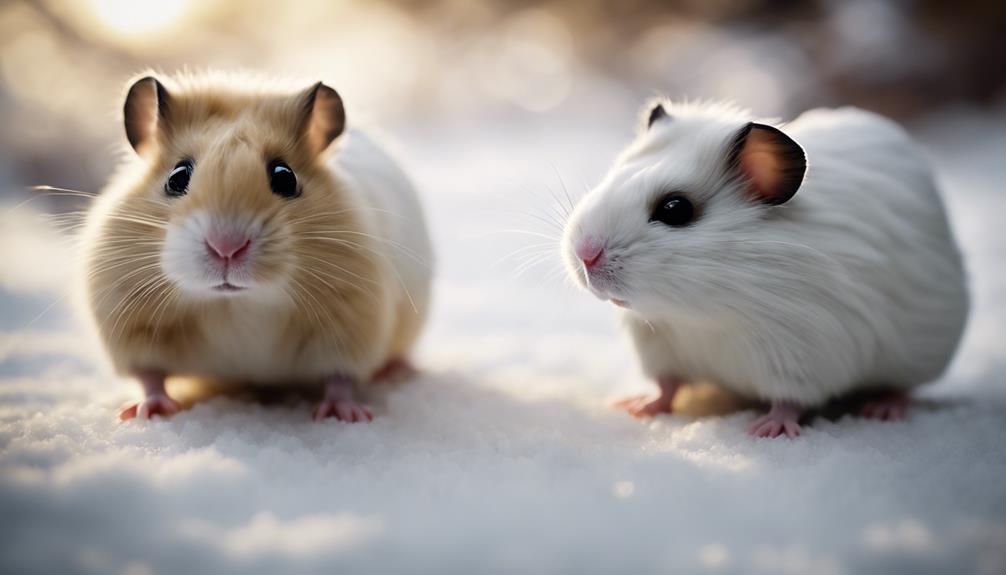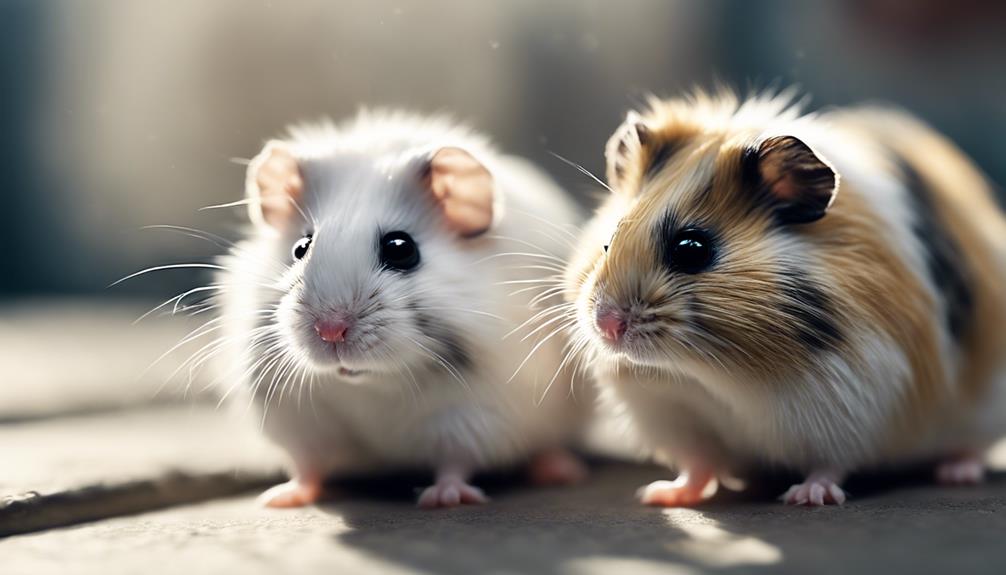How to Distinguish Between a Winter White and a Campbell's Dwarf Hamster

Differences Between Winter White and Campbell's Dwarf Hamsters:
Fur color, tail length, facial features, and behavior vary.
Understanding origins, health needs, and care requirements helps distinguish them.
Foster a deeper connection with these captivating creatures through unraveling their mysteries.
Physical Size and Shape
When comparing Winter White and Campbell's dwarf hamsters, their physical size and shape exhibit distinct differences that can help in distinguishing between the two species. In terms of weight differences, Winter White hamsters tend to be slightly larger than Campbell's dwarf hamsters. Winter Whites typically weigh between 20-50 grams, while Campbell's dwarfs fall within the 20-30-gram range. These weight variations can aid in identifying the species when observed side by side.
Moreover, body proportions play a significant role in telling these hamsters apart. Winter White hamsters have a more robust build with a slightly shorter body and stockier appearance compared to the slenderer frame of Campbell's dwarf hamsters. These differences are subtle but can be discerned with careful observation.
When it comes to coat texture and fur density, Winter White hamsters have a denser coat with a softer texture, while Campbell's dwarf hamsters have a sleeker coat with slightly less fur density. These distinctions in physical attributes provide valuable insights for those seeking to differentiate between these two charming hamster species.
Fur Color and Patterns
The fur color and patterns of Winter White and Campbell's Dwarf Hamsters offer valuable insights into distinguishing between the two species. The variations in fur color, from pure white to shades of grey and brown, can be a key indicator.
Additionally, distinctive markings such as dorsal stripes or patches of color can further aid in identification.
Fur Color Variations
Evaluating the fur color and patterns can be a key factor in distinguishing between Winter White and Campbell's Dwarf Hamsters. These tiny creatures exhibit a variety of fur color variations, ranging from snowy white to shades of gray and brown. Understanding these distinctions can help hamster enthusiasts identify the specific breed they are caring for. Below is a table highlighting some common fur colors seen in Winter White and Campbell's Dwarf Hamsters:
| Fur Color | Winter White Hamster | Campbell's Dwarf Hamster |
|---|---|---|
| White | Yes | No |
| Gray | Yes | Yes |
| Brown | Yes | Yes |
Distinctive Markings
Examining the intricate fur colorations and patterns on Winter White and Campbell's Dwarf Hamsters provides valuable insight into distinguishing between these two breeds. One key aspect to observe is the coat texture differences. Winter Whites tend to have a denser and softer coat compared to Campbell's Dwarf Hamsters, which have a slightly rougher texture.
Additionally, focusing on the face mask patterns can aid in differentiation. Winter Whites typically display a distinct line running down their face, separating the white fur from the grey. In contrast, Campbell's Dwarf Hamsters often exhibit a more blended face mask that seamlessly transitions between colors.
Tail Length and Shape

In distinguishing between Winter White and Campbell's Dwarf Hamsters, one notable difference lies in their tail lengths and shapes.
- Tail Length Comparison:
- Winter White Hamsters have slightly longer tails compared to Campbell's Dwarf Hamsters.
- Campbell's Dwarf Hamsters, on the other hand, possess shorter tails relative to Winter Whites.
- Tail Shape Differences:
- The tail of a Winter White Hamster tends to be more slender and elongated.
- Campbell's Dwarf Hamsters typically have shorter and thicker tails with a more robust appearance.
When observing these small rodents, paying attention to the length and shape of their tails can provide vital clues for differentiating between the two breeds. Winter Whites exhibit tails that are longer and more slender, while Campbell's Dwarf Hamsters showcase shorter, thicker tails with a sturdier build. By understanding these distinctions, one can confidently identify whether they're interacting with a Winter White or a Campbell's Dwarf Hamster.
Facial Features and Eyes
When differentiating between Winter White and Campbell's Dwarf Hamsters, a key aspect to consider is their distinctive facial features and eyes. Winter White hamsters typically have rounder faces with a slightly more pronounced snout compared to Campbell's Dwarf Hamsters, which have a sleeker, more triangular face shape. Additionally, their eye colors can vary, with Winter Whites often having dark eyes while Campbell's Dwarf Hamsters may have black or ruby-red eyes.
Observing their facial expressions can also provide clues about their breed. Winter Whites tend to have a curious and sometimes cheeky expression, while Campbell's Dwarf Hamsters often display a more alert and focused look.
When it comes to size comparison, Winter White hamsters are usually slightly larger than Campbell's Dwarf Hamsters, and their body shapes differ slightly as well, with Winter Whites appearing more robust and Campbell's Dwarf Hamsters having a slender build. By paying attention to these facial features and eyes, one can more easily distinguish between these two charming hamster breeds.
Behavior and Temperament

Winter White and Campbell's Dwarf hamsters have distinct traits in their behavior and temperament. Understanding these differences can help owners provide appropriate care and enrichment for their furry companions.
Winter White Traits
With a gentle and curious demeanor, Winter White hamsters exhibit a unique blend of playfulness and social behavior. These hamsters are known for their charming personality and delightful interactions with their human companions. Here are some key traits that make Winter White hamsters stand out:
- Social Creatures: Winter White hamsters enjoy the company of their fellow hamsters and humans alike.
- Active and Playful: These hamsters are energetic and love exploring their surroundings.
- Responsive to Training: Winter Whites can be trained to perform simple tricks and respond well to positive reinforcement.
- Curious Nature: Known for their inquisitive nature, Winter Whites are always eager to investigate new objects and environments.
Winter Whites make wonderful pets for those seeking a friendly and interactive companion.
Campbell's Dwarf Behavior
Campbell's Dwarf hamsters exhibit distinct behavioral patterns and temperaments that set them apart from other hamster breeds. These tiny creatures have interesting sleeping habits, often choosing to nap throughout the day and becoming more active during the twilight hours. In terms of social behaviors, they can be quite territorial and may show aggression towards other hamsters if not introduced properly. Communication methods vary from gentle squeaks to loud squeals, and they use scent marking as a way to navigate their surroundings. When it comes to handling preferences, Campbell's Dwarf hamsters generally prefer calm and gentle interactions, as sudden movements can startle them. Understanding these aspects of their behavior can help ensure a harmonious relationship between owners and their furry companions.
| Sleeping Habits | Napping during the day, active at dusk |
|---|---|
| Social Behaviors | Territorial, may exhibit aggression |
| Communication Methods | Squeaks, squeals, scent marking |
Temperament Differences
Understanding the distinct behavioral patterns and temperaments of dwarf hamsters is essential for fostering a harmonious relationship between owners and their furry companions.
- Handling differences: Winter White hamsters are generally more docile and can be easier to handle than Campbell's Dwarf hamsters.
- Socialization: Campbell's Dwarf hamsters may require more time and patience to socialize with humans compared to Winter Whites.
- Training techniques: Positive reinforcement methods work well for both Winter White and Campbell's Dwarf hamsters, but consistency is key for effective training.
- Bonding strategies: Spending quality time with your hamster through gentle interactions like hand-feeding and talking to them can help build a strong bond regardless of the breed.
Origin and Background

Originating in different regions of Asia, the Winter White and Campbell's dwarf hamsters have unique backgrounds that contribute to their distinct characteristics. The breeding history of these two species diverges, leading to notable genetic differences. Winter White hamsters, also known as Djungarian hamsters, were first discovered in Siberia and parts of Mongolia. In contrast, Campbell's dwarf hamsters were initially found in the steppes of Russia and Northern China. These geographic differences influenced their natural habitats, with Winter Whites adapting to colder climates and Campbell's hamsters thriving in slightly warmer environments.
The Winter White hamsters showcase a grayish coat that turns white during the winter months, aiding in camouflage against the snow. On the other hand, Campbell's dwarf hamsters have a darker coat that remains relatively consistent throughout the year. Understanding the origin and background of these hamsters provides insights into their evolution and helps enthusiasts appreciate the intricacies of each species.
Lifespan and Health Considerations
The longevity and well-being of Winter White and Campbell's dwarf hamsters are crucial aspects that hamster owners must carefully consider. These tiny creatures require attentive care to thrive and lead a healthy life. Here are some key points to keep in mind:
- Dietary needs: Providing a balanced diet rich in seeds, grains, fruits, and vegetables is essential for maintaining your hamster's health and ensuring a long lifespan.
- Exercise requirements: Regular physical activity is vital for preventing obesity and promoting overall well-being. Providing a suitable exercise wheel or ball for your hamster to run in is crucial.
- Health issues: Both Winter White and Campbell's dwarf hamsters are prone to dental problems, so offering chew toys can help keep their teeth healthy. Regular veterinary check-ups are also important to monitor for any potential health issues.
- Longevity factors: On average, Winter White hamsters live for about 1.5 to 2 years, while Campbell's dwarfs can reach 2 to 3 years with proper care. Creating a safe and stimulating environment can contribute to their longevity and quality of life.
Care and Habitat Requirements

Proper care and habitat setup are fundamental to ensuring the well-being and contentment of Winter White and Campbell's dwarf hamsters. These tiny creatures have specific diet preferences, needing a mix of high-quality hamster pellets, fresh vegetables, and occasional fruits. Ensuring a balanced diet is crucial for their health and longevity.
Exercise is vital for these energetic hamsters. Providing a wheel for them to run on and ample space to roam around is essential. Both species require a minimum cage size of 360 square inches of floor space, but more significant areas are always appreciated. When choosing bedding, opt for safe materials such as aspen shavings, paper-based bedding, or hay. These options provide comfort and safety, preventing any harm to the hamsters.
Frequently Asked Questions
Can Winter White and Campbell's Dwarf Hamsters Be Housed Together in the Same Cage?
Winter White and Campbell's Dwarf Hamsters should not be housed together due to compatibility concerns. Their behavior differences and housing considerations may lead to social dynamics issues. It is wise to provide separate habitats for these species.
Do Winter White and Campbell's Dwarf Hamsters Have Any Specific Dietary Requirements?
Winter White and Campbell's Dwarf Hamsters have specific dietary requirements. They need a balanced diet rich in protein, fresh veggies, and pellets. Exercise is vital for their well-being. Suitable treats include small portions of fruits and nuts.
Are Winter White and Campbell's Dwarf Hamsters Prone to Any Specific Health Issues?
Winter White and Campbell's Dwarf Hamsters are prone to common illnesses like respiratory infections and wet tail. Prevention includes maintaining a clean environment and providing a balanced diet. Prompt treatment of health risks is crucial for their well-being.
How Do Winter White and Campbell's Dwarf Hamsters Interact With Other Pets, Such as Cats or Dogs?
When introducing hamsters to cats or dogs, caution is crucial. Supervise interactions to ensure safety for all pets involved. It's wise to keep hamsters away from birds, fish, and reptiles due to potential risks.
Are There Any Specific Toys or Enrichment Activities That Are Recommended for Winter White and Campbell's Dwarf Hamsters?
For enriching their lives, owners can provide various options such as exercise wheels, tunnels, chew toys, and climbing structures. These toys and cage accessories not only keep them physically active but also mentally stimulated.









